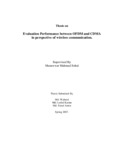| dc.contributor.advisor | Sohul, Munawwar Mahmud | |
| dc.contributor.author | Waheed, Md. | |
| dc.contributor.author | Karim, Lutful | |
| dc.contributor.author | Amin, Faisal | |
| dc.date.accessioned | 2010-10-10T06:05:23Z | |
| dc.date.available | 2010-10-10T06:05:23Z | |
| dc.date.copyright | 2007 | |
| dc.date.issued | 2007 | |
| dc.identifier.uri | http://hdl.handle.net/10361/411 | |
| dc.description | This thesis report is submitted in partial fulfillment of the requirements for the degree of Bachelor of Science in Computer Science and Engineering, 2007. | en_US |
| dc.description | Cataloged from PDF version of thesis report. | |
| dc.description | Includes bibliographical references (page 72). | |
| dc.description.abstract | In recent years orthogonal frequency division multiplexing (OFDM) and code division multiple access (CDMA) systems have gained considerable attention due to their use in high speed wireless communication. Both OFDM and CDMA have distinguishing features, for example, the former is almost completely immune to multipath fading effects, and the later has multi-user capability. Orthogonal frequency division multiplexing-code division multiple access (OFDM-CDMA) attempts to combine these features, so that we can achieve higher data rates for multiple users simultaneously.
The OFDM technique is an interesting approach in mobile communications in order to achieve a high spectral efficiency and to combat the frequency selectivity of the channel. OFDM effectively squeezes multiple modulated carriers tightly together, reducing the required bandwidth but keeping the modulated signals orthogonal so
they do not interfere with each other. CDMA is different than traditional ways like FDMA, TDMA in that it does not allocate frequency or time in user slots but gives the right to use both to all users simultaneously. To do this, it uses a technique known as Spread Spectrum. In effect,
each user is assigned a code which spreads its signal bandwidth in such a way that only the same code can recover it at the receiver end.
OFDM performs extremely well compared with CDMA, providing a very high tolerance to multipath delay spread, peak power clipping, and channel noise. In addition it provides a high spectral efficiency and resistance to multipath make it an extremely suitable technology to meet the demands of wireless data traffic. This has
made it not only ideal for such new technology like WiMAX and Wi-Fi but also currently one of the prime technologies being considered for use in future Next Generation Networks (NGN). | en_US |
| dc.format.extent | 73 pages | |
| dc.publisher | BRAC University | en_US |
| dc.rights | BRAC University thesis are protected by copyright. They may be viewed from this source for any purpose, but reproduction or distribution in any format is prohibited without written permission. | |
| dc.subject | Computer science and engineering | |
| dc.title | Evaluation performance between OFDM and CDMA in perspective of wireless communication | en_US |
| dc.type | Thesis | en_US |
| dc.contributor.department | Department of Computer Science and Engineering, BRAC University | |
| dc.description.degree | B. Computer Science and Engineering | |

